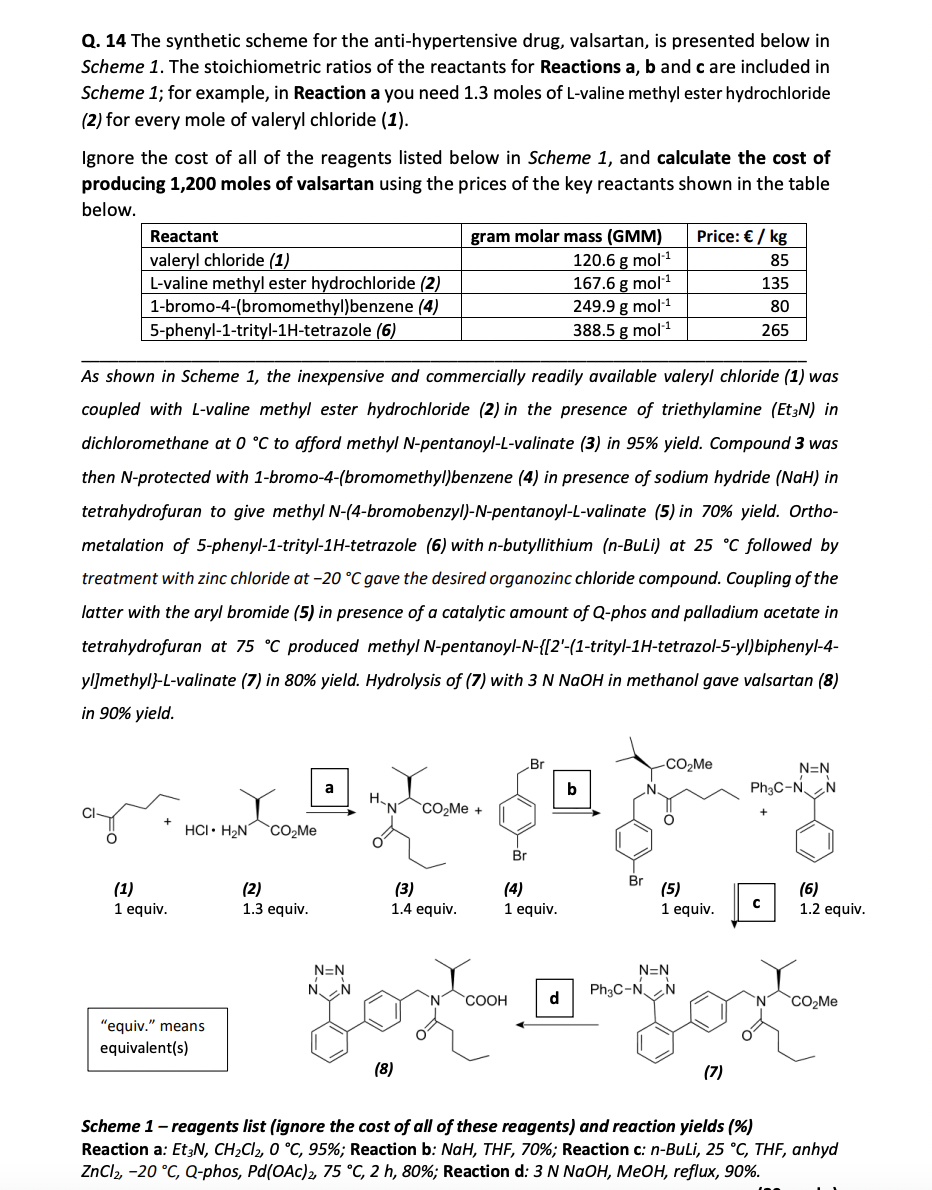Answered step by step
Verified Expert Solution
Question
1 Approved Answer
CAN YOU PLEASE SHOW ALL WORKINGS ON HOW TO OBTAIN REQUIRED QUANTITIES Q. 14 The synthetic scheme for the anti-hypertensive drug, valsartan, is presented below

CAN YOU PLEASE SHOW ALL WORKINGS ON HOW TO OBTAIN REQUIRED QUANTITIES
Q. 14 The synthetic scheme for the anti-hypertensive drug, valsartan, is presented below in Scheme 1. The stoichiometric ratios of the reactants for Reactions a,b and c are included in Scheme 1; for example, in Reaction a you need 1.3 moles of L-valine methyl ester hydrochloride (2) for every mole of valeryl chloride (1). Ignore the cost of all of the reagents listed below in Scheme 1, and calculate the cost of producing 1,200 moles of valsartan using the prices of the key reactants shown in the table below. As shown in Scheme 1, the inexpensive and commercially readily available valeryl chloride (1) was coupled with L-valine methyl ester hydrochloride (2) in the presence of triethylamine (Et3N) in dichloromethane at 0C to afford methyl N-pentanoyl-L-valinate (3) in 95% yield. Compound 3 was then N-protected with 1-bromo-4-(bromomethyl)benzene (4) in presence of sodium hydride (NaH) in tetrahydrofuran to give methyl N-(4-bromobenzyl)-N-pentanoyl-L-valinate (5) in 70% yield. Orthometalation of 5-phenyl-1-trityl-1H-tetrazole (6) with n-butyllithium (n-BuLi) at 25C followed by treatment with zinc chloride at 20C gave the desired organozinc chloride compound. Coupling of the latter with the aryl bromide (5) in presence of a catalytic amount of Q-phos and palladium acetate in tetrahydrofuran at 75C produced methyl N-pentanoyl-N-\{[2'-(1-trityl-1H-tetrazol-5-yl)biphenyl-4yl]methyl--L-valinate (7) in 80\% yield. Hydrolysis of (7) with 3NNaOH in methanol gave valsartan (8) in 90% yield. Scheme 1 - reagents list (ignore the cost of all of these reagents) and reaction yields (\%) Reaction a: Et3N,CH2Cl2,OC,95%; Reaction b: NaH,THF,70%; Reaction c: n-BuLi, 25C, THF, anhyd ZnCl2,20C,Q phos, Pd(OAc)2,75C,2h,80%; Reaction d: 3NNaOH,MeOH, reflux, 90%Step by Step Solution
There are 3 Steps involved in it
Step: 1

Get Instant Access to Expert-Tailored Solutions
See step-by-step solutions with expert insights and AI powered tools for academic success
Step: 2

Step: 3

Ace Your Homework with AI
Get the answers you need in no time with our AI-driven, step-by-step assistance
Get Started


